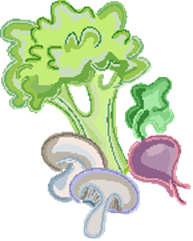VEGETARIAN, LACTO-OVO, AND VEGAN DIETS
 Approximately 7% of Americans choose a vegetarian diet, 1% choose a lacto-ovo vegetarian diet (no meat, fish or poultry flesh), and 0.1% follow a vegan diet (no animal foods) . These choices are based on cultural or religious traditions, perceived health benefits, or for philosophical reasons. Most vegetarian, lacto-ovo and vegan diets can meet the needs of growing children with appropriate planning or, in some cases, supplementation.
Approximately 7% of Americans choose a vegetarian diet, 1% choose a lacto-ovo vegetarian diet (no meat, fish or poultry flesh), and 0.1% follow a vegan diet (no animal foods) . These choices are based on cultural or religious traditions, perceived health benefits, or for philosophical reasons. Most vegetarian, lacto-ovo and vegan diets can meet the needs of growing children with appropriate planning or, in some cases, supplementation.
Are there risks from a vegetarian diet?
Without careful planning, a vegetarian diet might be deficient in Vitamin B12, protein, iron, and/or vitamin D. Healthcare providers should be aware of the rich sources for these nutrients so they can determine, through dietary history, which nutrients may be deficient in the child's diet and can counsel on ways to either alter dietary intake or supplement. In many cases, a single session with a dietician can be very helpful.
|
Nutrient |
Good Source |
Comments |
|
Calories |
Oils, nuts (beware of choking risk for small children!), nut butters and fruit juices. |
Energy intake in very restricted diets may be insufficient for infants just weaned from bottle or breast and small children. |
|
|
Combining legumes with rice or corn generally delivers all the essential amino acids in one meal. Mixtures of high protein sources is advisable (mixture of legumes, cereal, nuts seeds, fruits and other vegetables). Soy is a good source of protein, especially if supplemented with methionine, as it is in soy-based formulas. |
Vegetarian sources are usually sufficient in protein for growing children. Dietary consultation may be appropriate for helping a parent understand which combinations deliver a balanced supply of essential amino acids. |
|
Fats |
Consult a dietician. |
For children over 2 years, if dietary fat is below 15% of calories, special care must be taken to provide that essential fatty acid requirements are met. |
|
Vitamin B12 (Cobalamine) |
B12 is found in meat products. Levels are high in colostrum compared to human milk at 3 months post partum. B12 is found in breast milk in proportion to the amount of maternal ingested B12. |
B12 deficiency may result in megaloblastic anemia and neurologic abnormalities. Special attention should be paid to B12 consumption in vegan diets
|
|
Iron |
High in meats; some commercially available cereals are iron-fortified. |
Iron absorption is improved in presence of iron deficiency; impaired in presence of tannins (tea) and phytins (in foods high in fiber). Iron content in foods does not reflect bioavailability (e.g., 50% of iron available in human milk is absorbed, but only 4% of iron in fortified formula is absorbed.) |
|
Vitamin D |
Added to milk. Sunlight is excellent source for manufacture of Vitamin D in skin, liver and kidney. |
Infants are at risk for deficiency if swaddled and living in climates with reduced sunlight. |



